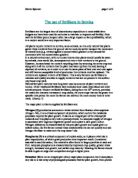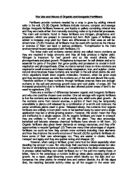These two types of bacteria are nitrifying bacteria. Through their activities nitrogen is made available to the roots of plants.
In most ecosystems nitrogen is primarily stored in living and dead . This organic nitrogen is converted into inorganic forms when it re-enters the via decomposition. , found in the upper soil layer, chemically modify the nitrogen found in organic matter from (NH3) to salts (NH4+). This process is known as and it is carried out by a variety of bacteria, , and .
In farming, the land is often used for multiple cropping so large amounts of fertilisers are needed to restore the soil’s nutrient. In addition the process of denitrification, where certain bacteria (e.g. Pseudomonas dentrificans) transform nitrate into various gaseous forms, such as N2O and N2, means 10 to 20% of all nitrate originating from fertiliser may be lost as a result. The use of fertilisers enables farmers to maintain soil quality and also provide crops with nutrients that are not present or depleted in many soils, inevitably boosting crop yields.
Expanding human populations and the need to feed this cause is what accelerated the use of fertilisers farming. Artificial fertilisers have been of immense benefit in helping to feed a rapidly expanding human population. An example is the rapid rise in food production since the Second World War, which is largely dependent on low-cost inputs of synthetic nitrogen fertiliser. Similarly, the production and harvest of high-yielding crops to feed the expanding human populations has resulted in the removal of large amounts of nutrients, much of which is not returned to the soil.
Farmers, therefore, utilise organic and inorganic fertilisers to return certain nutrients to the soil in order to optimise plant growth.
(3,2,5,6,1,11,12)
The increase in worldwide food production during the last century can be mostly attributed to the increased use of inorganic fertilisers in farming. The nutrients most commonly added in the form of fertilisers are nitrogen, phosphorus and potassium.
Nitrogen (N) in the form of ammonium nitrate. Nitrogen is a part of chlorophyll and thus plays a key role in photosynthesis. It is essential for plant growth, increasing seed and fruit production as well as improving the quality of leaf and forage crops. A lack of nitrogen is characterised by reduced plant growth and a yellowing colouring of the leaves. Furthermore, nitrogen is a necessary part of all proteins, enzymes and metabolic processes that are involved in the synthesis and transfer of energy.
Phosphorus (P) like nitrogen is essential for photosynthesis. It is also a vital component of nucleic acids and in the formation of starches and sugars, while encouraging rapid growth of the roots as well as blooming. An adequate amount of phosphorus present in the soil is characterised by early crop maturity, improved crop quality, increased root growth and stem strength. It also aids the transformation of solar energy into chemical energy.
Potassium (K) plays a key role in the vital processes required for plant growth, protein synthesis, photosynthesis, maintaining a constant water balance, fruit quality and reduction of diseases. Plants only absorb more nitrogen than potassium, while in some cases calcium is required in the second greatest quantities of all mineral elements.
Thus, it is clear that these three macronutrients are vital for optimum crop growth and maximising farmers’ yields, which in turn means greater profits for the farmer.
(3,1)
Fertilisers are essential in farming to ensure the precise amounts of nutrients are present in the soils, therefore maximising crop yields and profits. Thus, they form the largest item of a farmer’s discretionary expenditure. Good soil fertility means good crop/pasture production. To achieve this level of soil fertility and vigorous pasture growth usually means applying fertilisers.
Farmers use either organic or inorganic fertilisers. Organic fertilisers include manures, bone meal and other animal products and have long been used as a source of nutrients for cultivated soils. Approximately three- fourths of the nutrients harvested in crops grown on a farm may be recycled back to crop soils in the form of manure.
Inorganic fertilisers or artificial fertilisers are made from raw materials found in nature, which are then processed to make them more soluble and readily available to plants, both of which allow for more precise management and timely release of available nutrients to the crop. This provides the means for dramatic increases in crop yields, which are needed to meet the food needs of the world’s expanding population, since organic sources are not sufficient. The use of inorganic fertilisers also enables farmers to grow more crops in a shorter time period, which means the more the farmer can sell and thus the greater his/her profit.
Inorganic fertilisers have many advantages over organic fertilisers. Inorganic amendments provide, on a weight basis, many more nutrients than organic ones. An example is 100kg of an inorganic fertiliser, which provides as much nitrogen, phosphorus, and potassium as 2 tonnes of the average farm manure. In addition, transport cost for manure are considerably higher due to the water content of the manure, and their highly variable composition makes calculating application rates more difficult and less precise. Organic fertilisers such as manures and sludge may contain weeds and pathogenic organisms and have to therefore be treated appropriately.
However, organic fertilisers are ecologically and environmentally safer as they contain no toxins or pollutants. They provide a source of organic nutrients and trace elements to the crops, which will leave behind an organic soil-repairing residue each cropping season. In addition, they are easy to apply and require no expensive protective clothing for their application. Organic materials, especially those that are decomposed easily, improve soil structure, water-holding potential and cation exchange ability. Also, most organic amendments come free of cost, so they may provide the only economically viable source of nutrients for small-scale farmers in the developing world. Above all organic fertilisers continue to improve the soil condition while increasing crop productivity.
However, the majority of nutrients added to the soil, whether from organic or inorganic sources, are not taken up during the season of application but rather are incorporated into the complex nutrient cycle. Fertilisers’ most immediate benefit is to stimulate biological activity and nutrient cycling, and in thus increase the availability of existing nutrient pools.
Farmers tend to use a variety of fertiliser materials, as many different forms of chemical and physical forms of nitrogen exist. Some release nutrients slowly such as“turf-grade” fertilisers while most of the nitrogen in farm-grade fertilisers is readily available either in the form of ammonium nitrogen (NH4+) or nitrate nitrogen (NO3-). Similarly there are many different forms of phosphorus containing fertilisers. The most common are triple superphosphate, monoammonium phosphate, diammonium phosphate and ammonium polyphosphate liquid, of which are highly water-soluble. Generally, the higher the water solubility, the more effective the phosphorus source. This becomes extremely important for farmers who grow short season, fast growing crops with restricted root systems.
(5,6,8,4,1,10)
However, it is not as simple for farmers as applying fertilisers and expecting increased crop yields. Farmers have to take into account soil fertility, pasture utilisation, stocking rates, pasture composition and inevitably the economic considerations of whether applying fertilisers will mean increased yields and thus profit. As the concentration of a limiting nutrient increases, crop growth will increase correspondingly, until the optimum concentration for plant growth is reached. Increases beyond the suffiency range will lead to toxicity that will lead to reduced growth, where the law of diminishing returns will set in. At this stage, there is no point in adding more fertilisers because it does not increase the yield any more.
Plant growth is optimised when the concentration of available soil nutrient is within the sufficiency range.
Table: -The effect of adding fertiliser to crops growing on land resulting from the clearing of rain forest.
(1,9)
Examples of using fertilisers for farming
Crop yields; farm production and productivity have risen dramatically with the increases in fertiliser application rates. In the UK, in terms of the real value of farm output, national productivity rose by 24% between 1970 and 1985. For wheat, the average yield was 2.3 tonnes/ha in 1935, and 6.3 tonnes/ha in 1985, an increase of 177% over a fifty-year period. Likewise, in the USA agricultural productivity has seen staggering increases between 1920 and 1980. For example, US cornfields soared 333% from 21 to 91 bushels and acre and to date yields exceed 110 bushels an acre, of which can mostly be contributed to the use of fertilisers and improved plant varieties.
(7,2)
However, serious problems can occur when fertilisers are applied in too great quantities, of which the crops cannot absorb. The mineral ions in the fertiliser will be washed or leached from the soil and ultimately get washed into ponds or streams, which leads to eutrophication. This results in the rapid growth of algae and other plants to produce algal blooms. Many algal species, such as Pfiesteria, produce deadly toxins. The resulting toxins and anoxic conditions kill fish and other aquatic organisms, thereby destroying the balanced ecosystem.
(1,9)
World use of fertilisers for farming
In 1960/61, world nitrogen fertilizer nutrient consumption, in million tonnes was 10.83 but by 2000/01 it had increases over seven fold to 80.80 million tonnes. The Food and Agriculture Organization of the United Nations forecast that fertilizer consumption will have to increase from the present level of 138 million tonnes N+P2O5+K2O to between 167 and 199 million tonnes per year by 2030. This represents an annual growth rate of between 0.7 and 1.3 percent per annum, which compares with an average annual increase of 2.3% p.a. between 1970 and 2000.
(13)
Conclusion
Although fertilisers can prove to be invaluable for farmers in an effort to increase their crop yields, they can also be a hindrance to the environment and ultimately the farmer who will have to pay for the clean up operations. However, it is now recognised that greater fertiliser additions will not always increase crop yields. The nutrient levels of many soils, excluding that of sub-Saharan Africa and other developing regions, are already nearing optimal levels. Thus, farmers are more likely to benefit from yield increases from advances in nutrient and water use efficiency, improved crop rotations and the utilisation of higher-yielding crop varieties.
Sources
-
Soils, Dubbin.W, published by The Natural History Museum, London
(Page references 59,60, 64,69,70-74,104,105)
-
Food Adulteration and how to beat it: - The London Food Commission
(Page references 110,116,118,121)
-
Website-
-
Website-
-
Website- ww.prismiclight.com/organic.html
-
Website-
-
Website- Union of Concerned Scientists-
-
Website- PDF file- Soil fertility management-
-
Indge.B, Rowland.M and Baker.M. “A new introduction to biology” (2000)
- Webster's family encyclopaedia, Ottenheimer Publishers, book 4 page 926
-
Website-
-
Website- Nitrogen cycle diagram -
-
Website- http://www.fertilizer.org/ifa/statistics/indicators/ind_cn_world.asp







